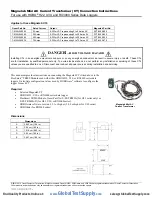
12
Alignment
Introduction and Precautions
The following procedures cover adjustments that are not
normally required once the transceiver has left the facto-
ry. However, if damage occurs and some parts subsequent-
ly be replaced, realignment may be required. If a sudden
problem occurs during normal operation, it is likely due
to component failure; realignment should not be done until
after the faulty component has been replaced.
We recommend that servicing be performed by authorized
Vertex Standard service technicians, experienced with the
circuitry and fully equipped for repair and alignment. If a
fault is suspected, contact the selling dealer for instruc-
tions regarding repair. Authorized Vertex Standard ser-
vice technicians have the latest configuration information,
and realign all circuits and make complete performance
checks to ensure compliance with factory specifications
after repairs.
Those who do undertake any of the following alignments
are cautioned to proceed at their own risk. Problems caused
by unauthorized attempts at realignment are not covered
by the warranty policy. Also, Vertex Standard must re-
serve the right to change circuits and alignment proce-
dures in the interest of improved performance, without
notifying owners.
Under no circumstances should any alignment be attempt-
ed unless the normal function and operation of the trans-
ceiver are clearly understood, the cause of the malfunc-
tion has been clearly pinpointed and any faulty compo-
nents replaced, and the need for realignment determined
to be absolutely necessary.
The following test equipment (and thorough familiarity
with its correct use) is necessary for complete realign-
ment. Most steps do not require all of the equipment list-
ed, but the interactions of some adjustments may require
that more complex adjustments be performed in a se-
quence. Do not attempt to perform only a single step un-
less it is clearly isolated electrically from all other steps.
Rather, have all test equipment ready before beginning,
and follow all of the steps in a section in the order they
are presented.
Required Test Equipment
m
Digital DC Voltmeter (high-Z, 1 M-Ohm/V)
m
DC Ammeter
m
RF Millivoltmeter
m
AC Voltmeter
m
RF Standard Signal Generator w/calibrated output and
dB scale, 0 dBµ = 0.5µV
m
Signal Generator with calibrated output
m
Spectrum Analyzer good to at least 1 GHz.
m
Frequency Counter
m
50-Ohm Dummy Load (200 watts)
m
100-Ohm Dummy Load (200 watts)
m
150-Ohm Dummy Load (200 watts)
m
In-Line Wattmeter (200 watts, 50-Ohm)
m
Linear Detector
m
RF Coupler
Alignment Preparation & Precautions
A 50-ohm RF Dummy load and in-line wattmeter must be
connected to the main antenna jack in all procedures that
call for transmission, except where specified otherwise.
Correct alignment is not possible with an antenna.
After completing one step, read the following step to de-
termine whether the same test equipment will be required.
If not, remove the test equipment (except dummy load
and wattmeter, if connected) before proceeding.
Correct alignment requires that the ambient temperature
be the same as that of the transceiver and test equipment,
and that this temperature be held constant between 68 °F~
86°F (20°C ~ 30°C). When the transceiver is brought into
the shop from hot or cold air, it should be allowed time to
come to room temperature before alignment.
Whenever possible, alignments should be made with os-
cillator shields and circuit boards firmly affixed in place.
Also, the test equipment must be thoroughly warmed up
before beginning.
Note
: Signal levels in dB referred to in this procedure are
based on 0 dBµ = 0.5 µV (closed circuit).
Summary of Contents for FT-857 HF
Page 4: ...4 Note...
Page 6: ...6 Note...
Page 7: ...7 Connection Diagram...
Page 8: ...8 Block Diagram...
Page 23: ...23 MAIN Unit Circuit Diagram...
Page 24: ...24 MAIN Unit Note...
Page 49: ...49 PLL Unit Circuit Diagram...
Page 55: ...55 PA Unit Circuit Diagram...
Page 56: ...56 PA Unit Note...
Page 67: ...67 PANEL Unit Circuit Diagram...
Page 81: ...81...













































